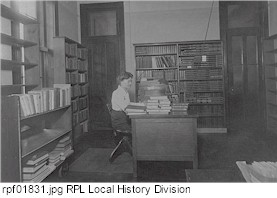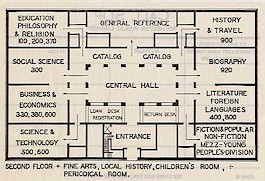The Rundel Memorial Building, Home to the Rochester Public Library
In a May 1936 article in the Rochester Gas & Electric News author Landis S. Smith asked, "What does the word library mean to you? Does it mean a stuffy silent place where bookworms gather the dust of ages? Well, if it does you’re sure not keeping up with the times…Snap out of it, Brother…Wake up and live! You’re missing a lot."
Smith was referring to the imminent opening of the Rundel Memorial Building on South Avenue, which was to be the central branch of the Rochester Public Library System. The building was dedicated on October 4, 1936, but its arrival was long awaited in the city.
Early Libraries:
The history of libraries in Rochester dates back to the 1820s and 1830s with the formation of literary social clubs such as the Rochester Athenaeum, which was founded in 1828, and the Mechanics’ Literary Association, founded in 1836. Groups such as these sponsored book collections that were often made available to the public. The two aforementioned groups merged in 1847 to form the Athenaeum and Mechanics Association. Their book collection grew to several thousand over the years. However, the association fell on hard times and was bankrupt by 1877. Its collection was sold.
Mortimer Reynolds, prominent lifelong Rochesterian and businessman, came to purchase the collection virtually intact. Reynolds sought to form a new library (comprised of the collection he bought) in honor of his father and brother, Abelard and William Reynolds, who were strong benefactors of the Athenaeum and Mechanics Association. The Reynolds Library was incorporated in 1884. After ironing out preparations, the library opened to the public in the Reynolds Arcade on East Main Street in 1886. It was a privately endowed free lending library that concentrated on a strong reference collection. Mortimer Reynolds died in 1892 and he left his home, a mansion on Spring Street, for the library’s new headquarters.
Exterior and interior views of the Reynolds Library on Spring Street
A City Library:
The Reynolds Library was open to the public. Other libraries, like the University of Rochester and the Rochester Free Academy libraries, were also open to the public at times. However, the people of Rochester wanted their own library. Finally, Mayor Hiram Edgerton signed an amendment to the city charter in 1911 providing for a Rochester Public Library. The library system was set up on a branch plan and branches were immediately proposed. It was decided to hold off on forming a central library for the moment until proper plans, location and financing could be decided. Exposition Park Branch, the first in the Rochester Public Library, was opened in 1912 (located in what is today Edgerton Park).

Interior of the Exposition Park Branch
A Central Library:
Budget problems, World War I and other encumbrances postponed the creation of a central library facility in the city although the public continued to support the idea. When the former Kimball Tobacco Factory (on the northeast corner of Court and Exchange) was taken over by the city as a City Hall Annex, space was provided in the building for the Central Library, which opened there in 1926.
eware e-wareMorton W. Rundel’s Gift:
While the Central Library in the old tobacco factory proved more suitable than expected, the construction of a new building was still in the works. Little notice was taken in 1911 when a Rochesterian named Morton W. Rundel died. However, people soon knew of the name Rundel when it was discovered he bequeathed $400,000 to the city for a library and fine arts building.

The many faces of Morton W. Rundel: the
library’s benefactor poses in front of mirrors in 1909
Numerous delays prevented the immediate construction of a building. There were debates about whether to build a library or a fine arts building, where to build the structure, was there enough money to build and whether or not to share space in the proposed building with a museum. Rundel’s heirs, claiming the city had not spent the bequest in a reasonable amount of time, filed a lawsuit against the city. The money was tied up in litigation until the courts ruled in favor of the city. Also there were ongoing negotiations with the trustees of the Reynolds Library concerning the merging of their collections.
A Dream Realized:
Twenty-two years after the Rochester Public Library was established, construction finally began on a central library. An agreement was completed with the Reynolds Library to combine their collections in the new building with the stipulation that a Reynolds Reference Library would be maintained in the Rochester Public Library. The Rundel bequest, after accruing interest over the years, now amounted to about one million dollars. A PWA (Public Works Administration) federal grant of several hundred thousand dollars supplemented the Rundel fund. A site had been chosen along the Genesee River on South Avenue between Court and Broad Streets. Ground was broken in December of 1933 after all arrangements had been made. The city of Rochester would at long last have the central library it had dreamed of.
Construction of the Rundel Memorial Building:
The library building, in progress
The local architectural firm of Gordon & Kaelber was chosen to design the library. The building has been described as a modern interpretation of the Renaissance style. The Ohio-based Hunkin-Conkey Construction Co. was hired as the general contractor. However, the work force (which numbered several hundred) was comprised mostly of local men. The Rundel Memorial Building is a remarkable building in its own right, but especially so because it was erected during the country’s worst financial depression. Its construction provided a much-needed labor source for local workers and an emotional boost for city residents in general.
Constructed of North Carolina granite and Indiana limestone the building measures 213 by 128 feet. It has three floors, a basement and a sub-basement. Its foundation was built over the Rochester Subway (which operated in the former Erie Canal bed from 1927 – 1956) and the Johnson & Seymour millrace (which was built in the early 1800s as a source of waterpower for area mills). The arched openings in the base of the library serve as spillways through which water from the millrace flows into the Genesee River.
The Cornerstone:
The cornerstone for the building (which reads 1934) was laid on June 15, 1935 in a ceremony officiated by Mayor Charles Stanton. An estimated crowd of 1,000 attended the event. A special box was placed in the cornerstone containing such items as historical books about Rochester, photos of people and places associated with the library, newspapers and other records of the city.
Mayor Stanton squared the stone with a level used by President Herbert Hoover in three cornerstone-layings in Washington DC. Addresses at the ceremony remembered Morton Rundel and his generous bequest.
The Dedication:
The Rundel Memorial Building of the Rochester Public Library was formally dedicated on October 4, 1936. The ceremony was held on the terrace at the main entrance of the building on South Avenue. Speakers at the event included Mayor Charles Stanton, University of Rochester President Alan Valentine, Toronto Public Library Director George H. Locke and Rochester Public Library Director John Adams Lowe.
|
Lowe, pictured above, either wrote or selected all the inscriptions that appear on the building. He himself penned the phrase carved above the main entrance "Books minister to man in his search for the enlightenment that reveals the meaning of life." The following quotes are from speeches made during the dedication ceremony:
| Alan Valentine said, "One wise man is not enough; but a democracy which loves and eagerly uses the storehouse of civilization this library symbolizes, can live forever." |
Two views of the Dedication Ceremony
| Arthur S. Tuttle, state director of the PWA, said, "Through the generosity of Morton Rundel, a fund was left to build this library. However, the sum was not sufficient for a suitable building and the money lay idle, until a PWA outright federal grant of a third of a million dollars was allotted, putting not only unemployed men, but unemployed money to work." |
|
 |
A PWA photo of the interior of the library circa 1937 and the layout of the first floor at the time of the library’s opening.
| George H. Locke said, "Depressions are inside as well as outside and books have a therapeutic value in enabling men to gain the courage and knowledge to fight their way through…" |
|
|
Two interior photographs showing the lobby floor (with in-laid zodiac signs) and the light fixture and skylight in the central hall.
| Charles Stanton said, "On behalf of the city, I present to the people of Rochester the Rundel Memorial Building which we here dedicate to the end that the lives of many people may be enriched through reading and in the profound hope that the Rochester Public Library housed therein may fulfill its high destiny. May it indeed be true that books shall minister to man in his search for the enlightenment that reveals the meaning of life." |
After the speeches, thousands of visitors entered the library to explore the new building. The Rundel Memorial Building officially opened for business on October 5, 1936, the day after the dedication. Reportedly, over 3200 books were checked out on the first day. Patrons of the new library enjoyed the architectural beauty of the building (inside and outside) as well as the expanded services it supplied to the city’s library system.
|
|
An exterior view of the South Avenue fašade of the Rundel Memorial Building and a close-up of the figures carved on this side of the building by NY sculptor Ulysses Ricci (photographs dated July 2002).
Expansion:
The Rundel Memorial Building has continually provided for its patrons’ needs over the years, updating its collections, services and facilities. On May 27, 1997 a 22.5 million-dollar addition opened on the opposite side of South Avenue and was named the Bausch & Lomb Public Library Building. An underground passage beneath South Avenue links the two buildings. That same year the Rundel Memorial Building underwent a multi-million dollar restoration project.
Conclusion:
The Rundel Memorial Building serves as an inspiration to the people of Rochester. Against all odds it was built during the Great Depression and its construction symbolized hope for the community. Not only because its construction and opening provided jobs, but more so because the knowledge held within its walls provided opportunity. People could learn about history, religion, biography, philosophy, science, literature, art, and the social sciences (as the inscriptions on the exterior walls beckoned people to do).*An engraving near the entrance of the Rundel Memorial Building of the Rochester Public Library promises anyone who enters its door that "The shadows will be behind you if you walk into the light." The library is the light of Rochester.
*See a complete description of Rundel Memorial Building Inscriptions
A view of the west side of the Rundel Memorial Building from across the Genesee River
For Further Reading:
Barnes, Joseph W. and Robert W. "From Books to Multimedia," Rochester History Vol. XXXVI No. 4 (1974).
McKelvey, Blake. "The Semi-Centennial of the Rochester Public Library," Rochester History Vol. XXIII No. 4 (1961).
Rochester Public Library Rundel Memorial Building Scrapbook 1925-1983. Compiled by Anthony Lembo in 1986. (RPL Local History Division)
Rochester Public Library Newspaper Clippings 1933-1937. Volume 7. (RPL Local History Division)
Send comments to Webmaster
Copyright Monroe County (NY) Library System
115 South Ave., Rochester, NY 14604